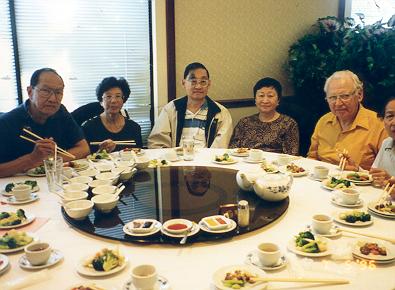Early
Days of QMH Radiotherapy Department
By
Rudy Khoo, O.B.E., MBBS (HK), FRCR (Lond.), FRCPE, FRCSE, DMRT (Eng.)
North Vancouver, B.C., Canada.
When
I completed my clinical assistant training at the University Medical Unit
in December, 1956, I was fortunate that Professor H.C. Ho (then
Radiological Specialist in-charge, Dr. H.C. Ho) embarked on his extensive
development plans for Hong Kong Government’s radiation therapy service.
I was successful in my application for the few radiotherapist training
posts advertised, and joined the Radiotherapy Department (RTD) in January,
1957.
Before the Professorial Block was built, the RTD shared the same wing on the first floor of Queen Mary Hospital with the Radiodiagnostic Department (RD). There was no waiting room. Both RD and RT patients crowded the corridor waiting for their turn to be served. For deep X-ray therapy, there was a 400 kV Maximar and a 250 kV Maxitron. There was a Bryant Symons Cobalt-60 (Co60) 60 curies teletherapy unit. As its maximum source-skin distance was only about 13 cm, it was used for treating more superficially seated tumours.
The Maximar was housed in a room right next to a RD reporting room. Understandably, the radiologists were concerned that when the Maximar was in a horizontal position, its X-ray beam would be pointing straight at them. Eventually, the Senior Hospital Physicist, G.F. Mauldon, measured the X-ray dose transmitted through the lead-lined wall and reassured the radiologists that the dose was well within the international permissible dose.
The Bryant Symons Co60 unit used compressed air or suction from a modified vacuum cleaner’s motor system to move the radio-active source from its safe through a flexible metal hose to the treatment head and back again at a completion of treatment. Once a while the source would get stuck during transit in the flexible hose. Mr. Mauldon earned the undying admiration of all in the Department when on these occasions he would dash into the treatment room armed with a long bamboo pole to give the hose a few bangs to dislodge the stuck radio-active source.

40 Years later, in Vancouver: Dr Rudy Khoo, Ms Ethel Ip, Mr SM Kwei, Dr CP Wong, Mr GF Mauldon, Mrs Mauldon, and obviously a few others………
On the training of radiologists and radiotherapists, Prof. Ho made significant achievements in getting the conjoint Board of the Royal College of Physicians of London and the Royal College of Surgeons of England to recognize the training in Hong Kong of qualified doctors for the D.M.R.D. cum D.M.R.T. part I examination. He also succeeded in arranging for the examination to be first held overseas in Hong Kong in October 1959. Successful candidates were then sent to the UK for training and preparation for the part II D.M.R.T examination. Subsequently, through the efforts of Prof. Ho, the training for the part II examination was also recognized by the conjoint Board and later by the Royal College of Radiologists. This led to the two parts of the F.R.C.R. examinations being held in alternate years in Hong Kong since 1984. These examinations were open to all qualified South-east Asian and Australasian candidates.
Advantage is taken here to remember the nucleus of radiotherapists in 1957 out of whom grew the present numbers of radiation oncologists. The team led by Prof. Ho comprised Drs C.H. Tsao, C.M. Yeung, Nancy Woo, Y.Y. Yeung and the author of this article, all of whom are still around to-day.
In writing this brief account, reference was made to the article, “Development of Radiation Oncology in Hong Kong up to 1985.” By Prof. John H.C. Ho et al, in the International Journal of Radiation Oncology, Biology, and Physics, Volume 37, No. 1, 1997. And to “The History of Medical Physics in Hong Kong as Remembered by G.F. Mauldon.”. Acknowledgment is also made for personal communications from G.F. Mauldon.